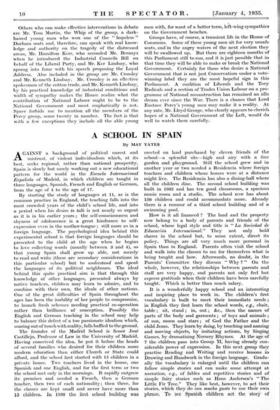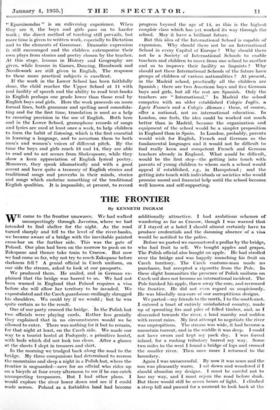A SCHOOL IN SPAIN
By MAY YATES
AGAINST a background of political unrest and mistrust, of violent individualism which, at its best, seeks regional, rather than national prosperity, Spain is slowly but surely working out a new educational pattern for the world in the Escuela Internacional Espaliola of Madrid, in which children are taught in three languages, Spanish, French and English or German, from the age of 4 to the age of 17.
By starting the study of languages at 11, as is the common practice in England, the teaching falls into the most crowded years of the child's school life, and into a period when his desire to talk is not nearly so urgent as it is in his earlier years ; the self-consciousness and shyness of adolescence is a great hindrance to self- expression even in the mother-tongue ; still more so in a foreign language. The psychological idea behind this experimental school is that foreign languages should be presented to the child at the age when he begins to love collecting words (usually between 3 and 4), so that young Spain shall grow up able, not merely to read and write (these are secondary considerations in this particular school) but to understand and speak the languages of its political neighbours. The ideal behind this quite practical aim is that through this knowledge of other languages, presented always by native teachers, children may learn to admire, and to combine with their own, the ideals of other nations. One of the great difficulties of Spain throughout the ages has been the inability of her people to compromise, to launch fresh schemes needing practical co-operation rather than brilliance of conception. Possibly the English and German teaching in the school may help to balance this defect of a too passionate idealism which, soaring out of touch with reality, falls baffled to the ground.
The founder of the Madrid School is Senor Jose Castillejo, Professor of Law in the University of Madrid. Having conceived the idea, he put it before the heads of several families who desired for their children more modern education than either Church or State could afford, and the school first started with 15 children in a private house. Two teachers lived in the house, one Spanish and one English, and for the first term or two the school met only in the mornings. It rapidly outgrew its premises and needed a French, then a German teacher, then two of each nationality; then three, for the classes are kept small and never have more than 15 children. In 1980 the first school building was erected on land purchased by eleven friends of the school—a splendid site—high and airy with a fine garden and playground. Still the school grew and in another year or two needed a Residencia where foreign teachers and children whose homes were at a distance might live. The Residencia has also a dining-hall where all the children dine. The second school building was built in 1932 and has ten good classrooms, a spacious music room and a studio. The school now has about 150 children and could accommodate more. Already there is a rumour of a third school building and of a swimming pool.
How is it all financed ? The land and the property now belong to a body of parents and friends of the school, whose legal style and title is " La Sociedad de Education Internacional." They not only hold shares in the school but, to some extent, direct its policy. Things are all very much more personal in Spain than in England. Parents often visit the school and walk into the classes to see for themselves what is being taught and how. Afterwards, no doubt, in the Parents' Committee they discuss " Why ? " On the whole, however, the relationships between parents and staff are very happy, and parents not only feel but express gratitude when their children have been carefully taught. Which is better than much salary.
It is a wonderfully happy school and an interesting and inspiring place to work in. The children's first vocabulary is built to meet their immediate needs ; in English they first learn the school words, e.g., chair, table ; sit, stand ; in, out ; &c., then the names of parts of the body and garments ; of toys and animals ; of sun, moon and stars ; of God the Father and the child Jesus. They learn by doing, by touching and naming and moving objects, by imitating actions, by Singing Games, by dramatizing Nursery Rhymes. At the age of 7 the children pass into Group II, having already con- siderable power of expression. In this next group they practise Reading and Writing and receive lessons in Drawing and Handwork in the foreign language. Gradu- ally the vocabulary is enlarged until the children can follow simple stories and can make some attempt at narration, e.g., of fables and repetitive stories and of simple fairy stories such as Hans Andersen's " The Little Fir Tree." They like best, however, to act their stories, which they do con much° gusto to use their own phrase. To 'See Spanish children act the story of " Epaminondas " is an enlivening experience. When they are 9, the boys and girls pass on to harder work ; the direct method of teaching still prevails, but more time is given to written work, especially to Dictation and to the elements of Grammar. Dramatic expression is still encouraged and the children extemporize their own plays from stories and poetry chosen by the teacher. At this stage, lessons in History and Geography are given, while lessons in Games, Dancing, Handwork and Needlework are still given in English. The response to these more practical subjects is excellent.
If the work in the Lower School has been faithfully done, the child reaches the Upper School at 11 with real facility of speech and the ability to read text-books in English perhaps one grade lower than those read by English boys and girls. Here the work proceeds on more formal lines, both grammar and spelling need consolida- ting and for the first time, translation is used as a help to ensuring precision in the use of English. Both here and in the Lower School, gramophone records of songs and lyrics are used at least once a week, to help children to form the habit of listening, which is the first essential in learning -a language, and to accustom them to both men's and women's voices of different pitch. By the time the boys and girls reach 13 and 14, they are able to read and to act scenes from Shakespeare, while they show a keen appreciation of English lyrical poetry. Moreover, they speak idiomatically and with a good accent and have quite a treasury of English stories and traditional songs and proverbs in their minds, stories and songs which enshrine something of the traditional English qualities. It is impossible, at present, to record progress beyond the age of 14, as this is the highest complete class which has yet worked its way through the school. May it have a brilliant future.
But this idea of the International School is capable of expansion. "Why should there not be an International School in every Capital of Europe ? Why should there not be a Society of International Schools to enable teachers and children to move from one school to another and so to improve their facility as linguists ? Why should not these International Schools of the future have groups of children of various nationalities ? At present, in the Madrid school, practically all the children are Spanish ; there are two American boys and five German boys and girls, but all the rest are Spanish. Only the teachers are " International." In Madrid the school competes with an older established Colegio Ingles, a Lycee Frances and a Colegio Aleman ; these, of course, offer a national, not an international education. In London, one feels, the idea could be worked out much better than in Madrid, because the organization and equipment of the school would be a simpler proposition in England than in Spain. In London, probably, parents would wish for English, French and German as the fundamental languages and it would not be difficult to find really keen and competent French and German teachers already in England. What would be difficult, would be the first step—the getting into touch with parents of young children to whom such a school would appeal if established, e.g., in Hampstead ; and the getting into touch with individuals or societies who would promise moral and financial help until the school became well known and self-supporting.







































 Previous page
Previous page